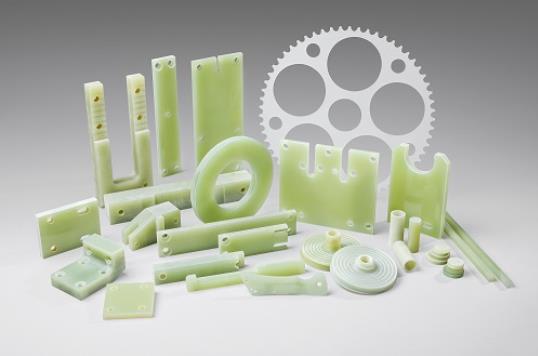ABS stands for acrylonitrile butadiene styrene. ABS plastic is made when acrylonitrile and polystyrene monomers are polymerized with butadiene rubber to create acrylonitrile butadiene styrene (ABS). This blending is typically accomplished using an emulsification process. Materials that would otherwise not mix are formulated into a single cohesive product (think milk, where fats, oil, and water do not separate out of solution but exist as a homogenous mixture). There are also patented formulation processes such as continuous mass polymerization, but emulsification is typically the standard approach utilized in creating ABS plastic.

The acrylonitrile in ABS adds to chemical resistance, fatigue resistance, hardness, and rigidity, increasing the heat deflection temperature. The styrene makes ABS shiny, hard, rigid, and easy to process. The polybutadiene in ABS is a rubbery substance that makes it tough and ductile at low temperatures.
This article explains nine uses of ABS plastic and if ABS plastic is good quality. It also addresses whether ABS can be recycled and if ABS plastic is harmful.
4.Automotive Industry
ABS is often used as a replacement for metal in the automotive industry. Various automotive parts that look for weight reduction factors use ABS thermoplastic. ABS is commonly used for parts that include dashboard components, seat backs, seat belt components, handles, door loners, pillar trim, and instrument panels.
Is ABS Plastic Good Quality?
ABS plastic is of good quality. ABS is considered a general-purpose engineering material. ABS is inexpensive and plentiful and is available in many different colors and form factors (pellets, tubes, bar, filament, etc.).
ABS is sturdy, lightweight, and ductile, being easily machined but retaining good resistance to chemicals, impacts, and abrasions. In addition, ABS is more heat-resistant than other thermoplastics in its weight class and can withstand multiple cycles of heating/cooling, making it a fully recyclable plastic. ABS can achieve a quality finish and is readily paintable. ABS has low heat conductivity and electrical conductivity.
Can ABS Be Recycled?
Yes, ABS can be recycled. It is 100% recyclable. In addition, ABS has an assigned recycling code, the number that designates the material with which a plastic object is made to help streamline the recycling process. ABS’s recycling code is seven (7). The code can be found at the bottom of a plastic item, depicted as the number seven inside the recycling symbol with revolving arrows forming a triangle.
However, most municipalities don’t recycle number seven plastics. They usually only recycle numbers one and two. This restriction means that ABS waste may not be recycled automatically after the municipal or garbage truck picks it up.
Manufacturers can reuse and recycle ABS, even if local governments do not. ABS plastic is entirely recyclable and mostly biocompatible. ABS plastic can easily be merged with other materials to create different commercial products that are of high quality yet cost-effective.
Many industries use old pre-existing ABS plastic products as a starting material for creating ABS plastic. Due to its 100% recyclability, ABS products can be heated, liquified, and remolded into new products multiple times.
Is ABS Plastic Harmful?
ABS plastic is not harmful in its typical uses. It is a petroleum-based plastic that is generally safe in its solid form, releasing no known carcinogens and being used throughout food processing applications.
However, medical device manufacturers prohibit using ABS in medical implants, as its long-term health effects within the body are unknown but thought to be negative. When melted, ABS plastic has an unmistakable foul odor that can cause discomfort and, in the worst case, physical symptoms. The medical consensus is that ABS plastic fumes are dangerous to inhale or be exposed to for short and long periods.
The fact that ABS is dangerous to inhale is especially pertinent to 3D printing applications, where filament-based printers heat ABS to fabricate parts, releasing billions of particles per minute. Without proper ventilation, these fumes can accumulate and cause toxicity in users, so it is highly recommended to use a fume hood or to print in a well-ventilated area to prevent exposure. In addition, this precaution applies to injection molding applications, where large quantities of material are melted and cooled several thousands of times in a workday, posing a serious threat to personnel if not addressed by safety measures..
Summary
This article provided a review of some of the primary uses of ABS plastic.To learn more about ABS plastic contact a PROTO MFG representative.
PROTO MFG provides a wide range of manufacturing capabilities and other value-added services for all of your prototyping and production needs. Visit our website to learn more or to request a free, no-obligation quote.